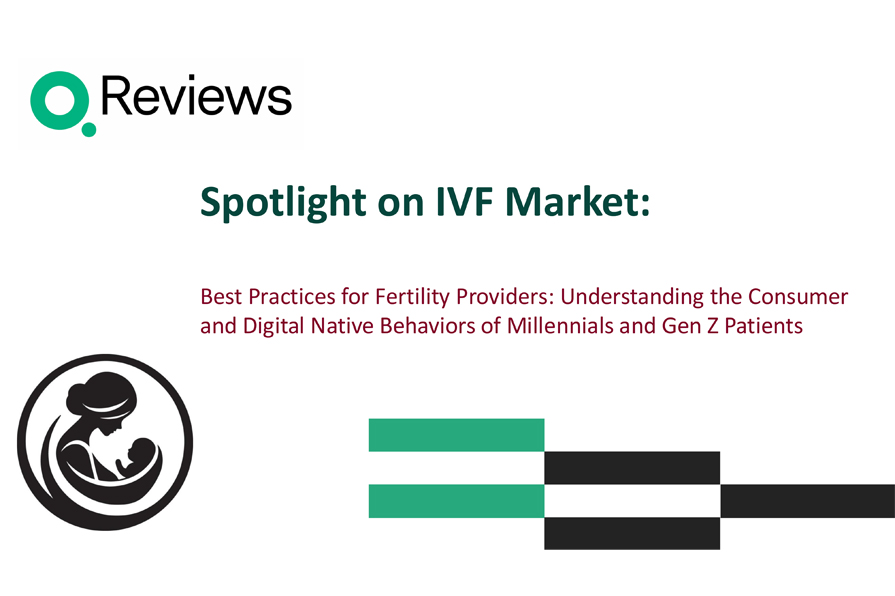
3 Ways to Improve the Fertility Journey With Digital Tools

Few medical fields are in as exciting of a stage as reproductive endocrinology and infertility (REI) is today, especially in the realm of the fertility journey. Between major technological advancements, increased awareness, and improved access, REI is growing by leaps and bounds. Of course, with that growth comes challenges as well.
With demand outpacing availability, increased patient expectations, and staffing shortages, REI clinics are being asked to do more with less. Fortunately, that’s where technology comes in. Using digital health solutions, REI clinics can better engage, serve, and grow their patient base.
That was the subject of our recent webinar with Paul Verrastro, Senior Vice President of Operations at First Fertility; Colin Thomas, Vice President of Operations at Ivy Fertility; and Danielle Soltesz, President at RMA of New York. In it, Quality Reviews CEO Edward Shin, MD talked with the three REI leaders about using digital tools to meet evolving patient expectations.
Read on for some highlights of their conversation, and register to view the full webinar.
1. Create Personalized Pathways
All three REI leaders agreed: Patient expectations have increased exponentially in recent years. In a day and age when “customer obsession” has become a core business principle, it’s only natural. Key among these expectations is personalization. After all, any website, app, or online service you use today will serve you with tailor-made content, ads, and experiences. And patients are expecting their doctors’ offices to act the same way.
“It was much easier 15 years ago because we were dealing with a narrower demographic of patients. They came in, got a new patient packet, and that was it,” Verrastro said.
“It’s not always one type of patient that we’re seeing,” Soltesz agreed. “There are all sorts of different people coming into our doors. We’re forced to think differently about how we can access, engage, and support them.”
A LQBGTQ couple coming to an REI clinic, for example, will expect their new patient paperwork to reflect their circumstances. References to a male partner can come across as insensitive and may even influence them to choose another provider. Patients who come in to freeze their eggs, meanwhile, may not identify with messaging prioritizing immediate pregnancies and births.
Both Verrastro and Soltesz use the Q Reviews platform to create systems that categorize patients, ensuring they get information that is relevant to their experience and reflective of who they are. By creating pre-appointment check-in workflows on Q Notify, for example, REI clinics can deliver relevant information before patients even step foot in the door.
“Designing systems that efficiently sort these folks out is a big evolution. It helps us understand which packages they should get, and when they should get them,” Verrastro said. “Before, we were relying on people to do that — but technology makes it more efficient and accurate.”
Read more: IVF in 2024: Trends, Challenges, & Opportunities
2. Provide Educational Resources & Instant Updates
For most patients, the fertility journey is fraught with emotion. Beyond the natural anxiety that comes along with a medical procedure, their family’s future is up in the air. Waiting on information can feel like an eternity, and often results in attempts to fill in the gaps on their own.
“As the patient population gets younger, they’re used to information being readily available at any given moment. When information about a process or the results of a procedure aren’t immediately available, your patients are on the phone, asking what’s next,” Thomas said.
This happens “even if it’s only been a few minutes since they left the office,” he added. “It’s challenging to keep patients engaged when they want to know everything right this second.”
Soltesz shared that RMA of New York supports patients by always trying to anticipate their needs. Part of this includes sending “short video clips to make sure that patients are grasping the concepts team members are trying to communicate.” For example, they’ll send patients a text message with a link to an instructional video to help them feel comfortable administering their first Lupron injection.
RMA of New York also sends educational resources when a patient is waiting on results, like after an embryo transfer.
“We know that while people are waiting, they’re Googling, they’re going to Facebook groups — they’re going down a rabbit hole. And that’s not good for anyone because we can’t control the source of those data points,” Soltesz said. “I think it’s up to us in the industry to provide evidence-based, knowledgeable sources for the questions they face throughout their fertility journey.”
And as soon as you have procedure results, make sure to share them with patients through a high-engagement channel like SMS text message. With emails getting lost in spam folders, 80% of people ignoring phone calls when they don’t recognize the number, and patient portal adoption so inconsistent, texts are often the best way to ensure patients see an update as quickly as possible.
Read more: How Quality Reviews Helps IVF & Fertility Clinics
3. Send Regular Patient Satisfaction Surveys
According to Soltesz, sending digital patient satisfaction surveys was a game-changer for RMA of New York. While traditional surveys are slow-moving, infrequent, and cluttered with unnecessary data, digital surveys provide valuable feedback in real time.
“I remember working at hospital systems and having Press Ganey surveys mailed out. When you get the results, you’re just trying to sort through what’s actionable. I found it to be challenging as an operator,” Soltesz said.
With Q Connect, RMA of New York can solicit and receive actionable feedback within moments. Having a platform at their fingertips at all times “opens our eyes as operators,” Soltesz said. “You know what you need to do to align and shift towards better. The power of technology and real-time patient feedback allows us to evolve our operations. It doesn’t get better than that.”
“I get the sense that poor online reviews have gone down at First Fertility since we’ve started using Q Reviews because people have the opportunity to be heard through their phone,” Verrastro said. “Providing them with that portal has diminished the need to leave negative feedback on Yelp or Google reviews. And most importantly, we can take action immediately.”
Ivy Fertility has also been able to perform service recovery to turn negative experiences around thanks to real-time feedback from Q Reviews.
“With Q Reviews, we’re able to deliver on our service promise throughout the journey across departments with every interaction. And if we’re falling short, we find out quickly, because patients aren’t afraid to tell us,” Thomas said.
“Even when an engaged patient isn’t happy, they’re at least communicating what their needs are. When you understand those needs, you can meet them,” Thomas added. “I think that’s one of the most important things we can do as operators — to help our teams and ourselves engage with our patients in a deep, meaningful way so that they can get the care that they seek.”
And when patients are happy, receiving that positive feedback is valuable as well.
“It’s nice to get specific names of individuals who are going above and beyond in their duties so that we can recognize and reward them,” Thomas said.
Verrastro agreed that the positive feedback they receive through Q Reviews helps First Fertility identify and appreciate outstanding team members.
“You can shout from the rooftops and celebrate your team for what they’re doing well,” Soltesz said.
Given that recognition motivates 80% of employees to work harder and makes them nearly six times more likely to stay at their jobs, actions like these can have a material impact on employee satisfaction, productivity, and turnover rates.
Using Technology to Create a Human Touch
While patient experience should be a priority in all medical fields, it’s especially important in REI, where emotions run so high.
“Although we’re in health care, we’re still in customer service. At the end of the day, we’re driven by the needs and wants of the customer. In our case, that means happy, healthy families,” Thomas said.
Customer service, Verrastro added, “is critical because it impacts our conversions, referrals, and brand identity.”
And as part of providing great service, a patient engagement strategy is essential. It’s on administrators, Verrastro believes, to take a holistic look at how patients are being engaged across their journey.
“Delivering on a patient’s expectations takes more than just one person. It’s the physicians, the nurse, the medical assistant, the phlebotomist, the anesthesiologist, the embryologist, you name it. There’s a whole crew of people combining to make that experience for the patient work well — not just from the clinical side, but also from a personal one,” Thomas said.
“I think what sets a good experience apart from others is when those personal touch points are positive, engaging, and meeting patient expectations, whatever those may be,” Thomas added.
While incredible employees are at the heart of those interactions, “technology is the perfect partner for that,” Soltesz said. “There’s so much opportunity to supplement what our amazing team members do.”
“We must evolve. We must adapt. We must try new things. We’ve got to get uncomfortable. And a big part of that is the adoption of new technologies — seeing what works best for your practice, patient population, and environment,” Soltesz added. “But what we can’t do is stay stagnant. You can’t just keep doing the things that worked 20 years ago or 10 years ago, because that’s not the way to meet the needs of the patients of tomorrow.”
To hear more— including the advantages of fertility networks, the potential AI has to transform the field, and advice for REI grads — register to download the full webinar. And if you want to learn more about how Quality Reviews can help your REI practice, don’t hesitate to reach out and schedule a demo.








